Zhiguo Cao
Identity-Preserving Image-to-Video Generation via Reward-Guided Optimization
Oct 16, 2025Abstract:Recent advances in image-to-video (I2V) generation have achieved remarkable progress in synthesizing high-quality, temporally coherent videos from static images. Among all the applications of I2V, human-centric video generation includes a large portion. However, existing I2V models encounter difficulties in maintaining identity consistency between the input human image and the generated video, especially when the person in the video exhibits significant expression changes and movements. This issue becomes critical when the human face occupies merely a small fraction of the image. Since humans are highly sensitive to identity variations, this poses a critical yet under-explored challenge in I2V generation. In this paper, we propose Identity-Preserving Reward-guided Optimization (IPRO), a novel video diffusion framework based on reinforcement learning to enhance identity preservation. Instead of introducing auxiliary modules or altering model architectures, our approach introduces a direct and effective tuning algorithm that optimizes diffusion models using a face identity scorer. To improve performance and accelerate convergence, our method backpropagates the reward signal through the last steps of the sampling chain, enabling richer gradient feedback. We also propose a novel facial scoring mechanism that treats faces in ground-truth videos as facial feature pools, providing multi-angle facial information to enhance generalization. A KL-divergence regularization is further incorporated to stabilize training and prevent overfitting to the reward signal. Extensive experiments on Wan 2.2 I2V model and our in-house I2V model demonstrate the effectiveness of our method. Our project and code are available at \href{https://ipro-alimama.github.io/}{https://ipro-alimama.github.io/}.
Dual-Camera All-in-Focus Neural Radiance Fields
Apr 23, 2025Abstract:We present the first framework capable of synthesizing the all-in-focus neural radiance field (NeRF) from inputs without manual refocusing. Without refocusing, the camera will automatically focus on the fixed object for all views, and current NeRF methods typically using one camera fail due to the consistent defocus blur and a lack of sharp reference. To restore the all-in-focus NeRF, we introduce the dual-camera from smartphones, where the ultra-wide camera has a wider depth-of-field (DoF) and the main camera possesses a higher resolution. The dual camera pair saves the high-fidelity details from the main camera and uses the ultra-wide camera's deep DoF as reference for all-in-focus restoration. To this end, we first implement spatial warping and color matching to align the dual camera, followed by a defocus-aware fusion module with learnable defocus parameters to predict a defocus map and fuse the aligned camera pair. We also build a multi-view dataset that includes image pairs of the main and ultra-wide cameras in a smartphone. Extensive experiments on this dataset verify that our solution, termed DC-NeRF, can produce high-quality all-in-focus novel views and compares favorably against strong baselines quantitatively and qualitatively. We further show DoF applications of DC-NeRF with adjustable blur intensity and focal plane, including refocusing and split diopter.
TacoDepth: Towards Efficient Radar-Camera Depth Estimation with One-stage Fusion
Apr 16, 2025Abstract:Radar-Camera depth estimation aims to predict dense and accurate metric depth by fusing input images and Radar data. Model efficiency is crucial for this task in pursuit of real-time processing on autonomous vehicles and robotic platforms. However, due to the sparsity of Radar returns, the prevailing methods adopt multi-stage frameworks with intermediate quasi-dense depth, which are time-consuming and not robust. To address these challenges, we propose TacoDepth, an efficient and accurate Radar-Camera depth estimation model with one-stage fusion. Specifically, the graph-based Radar structure extractor and the pyramid-based Radar fusion module are designed to capture and integrate the graph structures of Radar point clouds, delivering superior model efficiency and robustness without relying on the intermediate depth results. Moreover, TacoDepth can be flexible for different inference modes, providing a better balance of speed and accuracy. Extensive experiments are conducted to demonstrate the efficacy of our method. Compared with the previous state-of-the-art approach, TacoDepth improves depth accuracy and processing speed by 12.8% and 91.8%. Our work provides a new perspective on efficient Radar-Camera depth estimation.
Free4D: Tuning-free 4D Scene Generation with Spatial-Temporal Consistency
Mar 26, 2025Abstract:We present Free4D, a novel tuning-free framework for 4D scene generation from a single image. Existing methods either focus on object-level generation, making scene-level generation infeasible, or rely on large-scale multi-view video datasets for expensive training, with limited generalization ability due to the scarcity of 4D scene data. In contrast, our key insight is to distill pre-trained foundation models for consistent 4D scene representation, which offers promising advantages such as efficiency and generalizability. 1) To achieve this, we first animate the input image using image-to-video diffusion models followed by 4D geometric structure initialization. 2) To turn this coarse structure into spatial-temporal consistent multiview videos, we design an adaptive guidance mechanism with a point-guided denoising strategy for spatial consistency and a novel latent replacement strategy for temporal coherence. 3) To lift these generated observations into consistent 4D representation, we propose a modulation-based refinement to mitigate inconsistencies while fully leveraging the generated information. The resulting 4D representation enables real-time, controllable rendering, marking a significant advancement in single-image-based 4D scene generation.
Exploring Contextual Attribute Density in Referring Expression Counting
Mar 16, 2025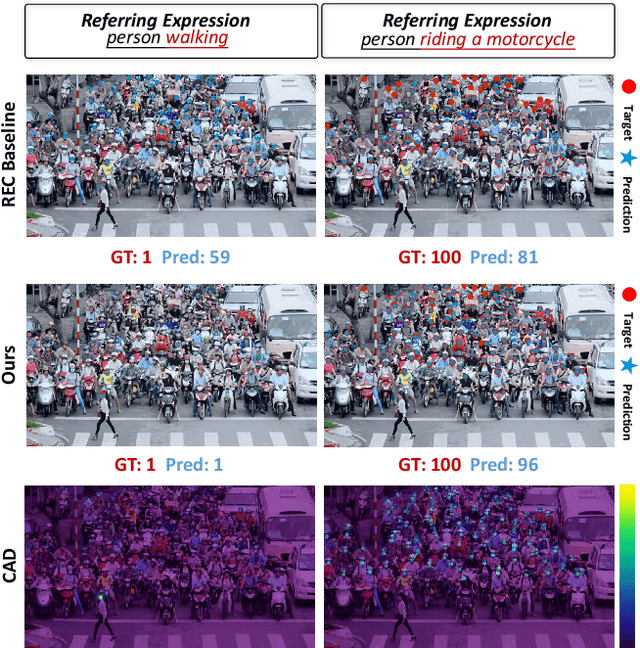
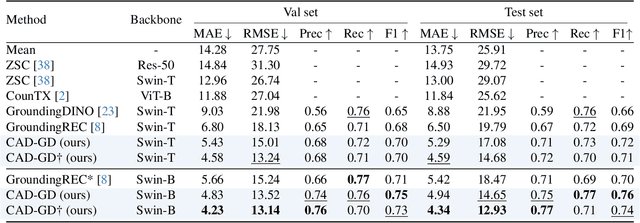
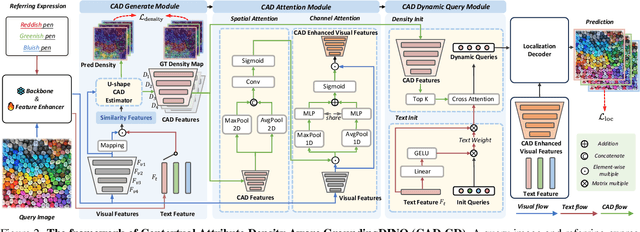
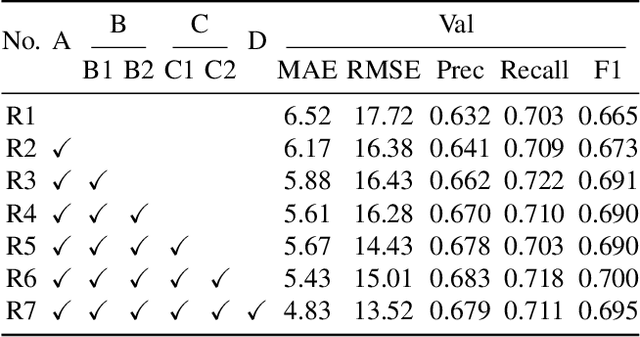
Abstract:Referring expression counting (REC) algorithms are for more flexible and interactive counting ability across varied fine-grained text expressions. However, the requirement for fine-grained attribute understanding poses challenges for prior arts, as they struggle to accurately align attribute information with correct visual patterns. Given the proven importance of ''visual density'', it is presumed that the limitations of current REC approaches stem from an under-exploration of ''contextual attribute density'' (CAD). In the scope of REC, we define CAD as the measure of the information intensity of one certain fine-grained attribute in visual regions. To model the CAD, we propose a U-shape CAD estimator in which referring expression and multi-scale visual features from GroundingDINO can interact with each other. With additional density supervision, we can effectively encode CAD, which is subsequently decoded via a novel attention procedure with CAD-refined queries. Integrating all these contributions, our framework significantly outperforms state-of-the-art REC methods, achieves $30\%$ error reduction in counting metrics and a $10\%$ improvement in localization accuracy. The surprising results shed light on the significance of contextual attribute density for REC. Code will be at github.com/Xu3XiWang/CAD-GD.
Self-Distilled Depth Refinement with Noisy Poisson Fusion
Sep 26, 2024
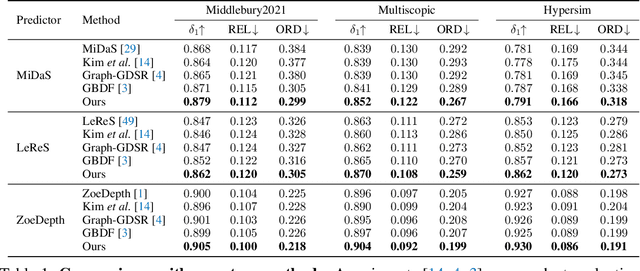


Abstract:Depth refinement aims to infer high-resolution depth with fine-grained edges and details, refining low-resolution results of depth estimation models. The prevailing methods adopt tile-based manners by merging numerous patches, which lacks efficiency and produces inconsistency. Besides, prior arts suffer from fuzzy depth boundaries and limited generalizability. Analyzing the fundamental reasons for these limitations, we model depth refinement as a noisy Poisson fusion problem with local inconsistency and edge deformation noises. We propose the Self-distilled Depth Refinement (SDDR) framework to enforce robustness against the noises, which mainly consists of depth edge representation and edge-based guidance. With noisy depth predictions as input, SDDR generates low-noise depth edge representations as pseudo-labels by coarse-to-fine self-distillation. Edge-based guidance with edge-guided gradient loss and edge-based fusion loss serves as the optimization objective equivalent to Poisson fusion. When depth maps are better refined, the labels also become more noise-free. Our model can acquire strong robustness to the noises, achieving significant improvements in accuracy, edge quality, efficiency, and generalizability on five different benchmarks. Moreover, directly training another model with edge labels produced by SDDR brings improvements, suggesting that our method could help with training robust refinement models in future works.
DreamMover: Leveraging the Prior of Diffusion Models for Image Interpolation with Large Motion
Sep 15, 2024
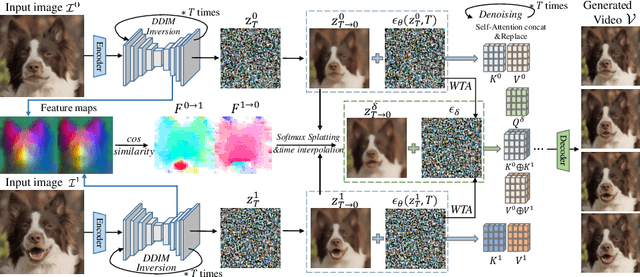

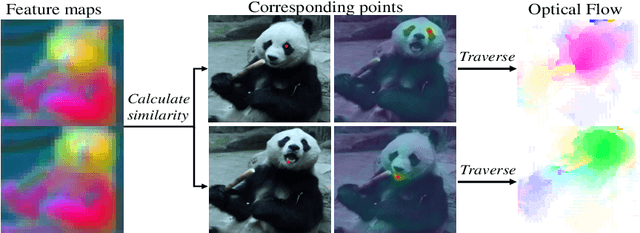
Abstract:We study the problem of generating intermediate images from image pairs with large motion while maintaining semantic consistency. Due to the large motion, the intermediate semantic information may be absent in input images. Existing methods either limit to small motion or focus on topologically similar objects, leading to artifacts and inconsistency in the interpolation results. To overcome this challenge, we delve into pre-trained image diffusion models for their capabilities in semantic cognition and representations, ensuring consistent expression of the absent intermediate semantic representations with the input. To this end, we propose DreamMover, a novel image interpolation framework with three main components: 1) A natural flow estimator based on the diffusion model that can implicitly reason about the semantic correspondence between two images. 2) To avoid the loss of detailed information during fusion, our key insight is to fuse information in two parts, high-level space and low-level space. 3) To enhance the consistency between the generated images and input, we propose the self-attention concatenation and replacement approach. Lastly, we present a challenging benchmark dataset InterpBench to evaluate the semantic consistency of generated results. Extensive experiments demonstrate the effectiveness of our method. Our project is available at https://dreamm0ver.github.io .
Training Matting Models without Alpha Labels
Aug 20, 2024



Abstract:The labelling difficulty has been a longstanding problem in deep image matting. To escape from fine labels, this work explores using rough annotations such as trimaps coarsely indicating the foreground/background as supervision. We present that the cooperation between learned semantics from indicated known regions and proper assumed matting rules can help infer alpha values at transition areas. Inspired by the nonlocal principle in traditional image matting, we build a directional distance consistency loss (DDC loss) at each pixel neighborhood to constrain the alpha values conditioned on the input image. DDC loss forces the distance of similar pairs on the alpha matte and on its corresponding image to be consistent. In this way, the alpha values can be propagated from learned known regions to unknown transition areas. With only images and trimaps, a matting model can be trained under the supervision of a known loss and the proposed DDC loss. Experiments on AM-2K and P3M-10K dataset show that our paradigm achieves comparable performance with the fine-label-supervised baseline, while sometimes offers even more satisfying results than human-labelled ground truth. Code is available at \url{https://github.com/poppuppy/alpha-free-matting}.
Towards Robust Monocular Depth Estimation in Non-Lambertian Surfaces
Aug 12, 2024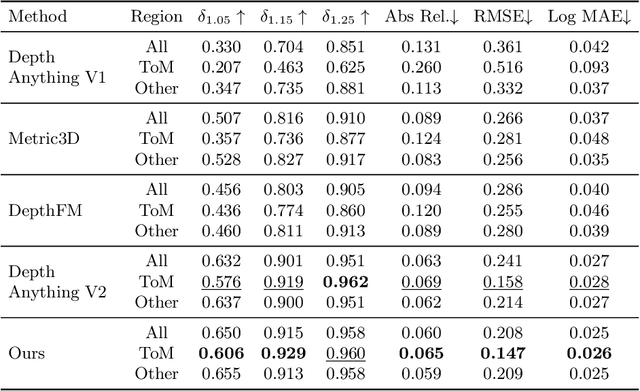
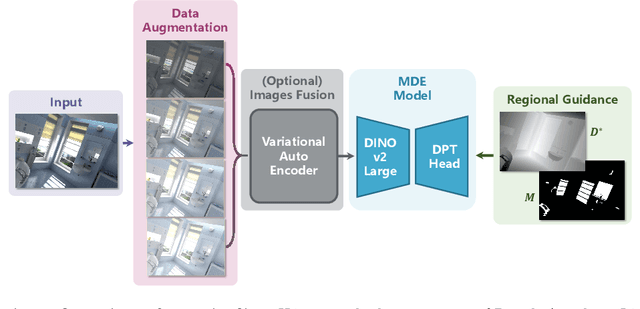
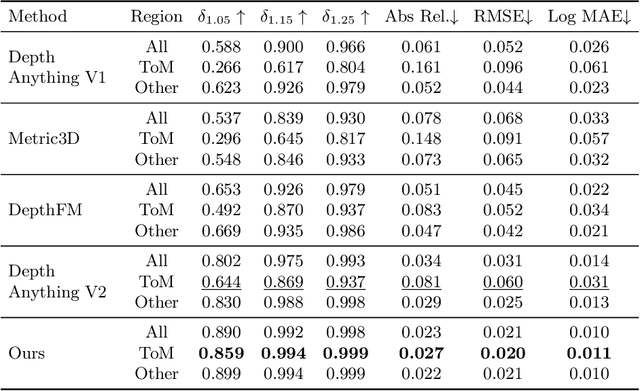
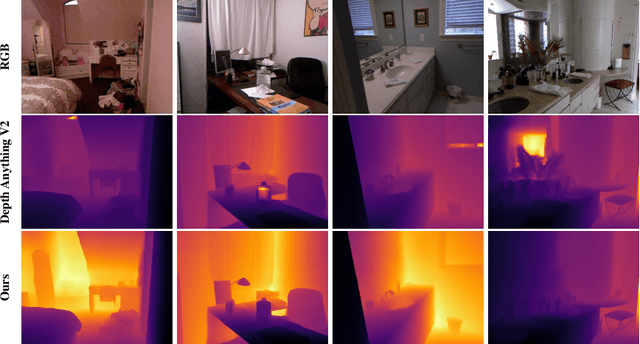
Abstract:In the field of monocular depth estimation (MDE), many models with excellent zero-shot performance in general scenes emerge recently. However, these methods often fail in predicting non-Lambertian surfaces, such as transparent or mirror (ToM) surfaces, due to the unique reflective properties of these regions. Previous methods utilize externally provided ToM masks and aim to obtain correct depth maps through direct in-painting of RGB images. These methods highly depend on the accuracy of additional input masks, and the use of random colors during in-painting makes them insufficiently robust. We are committed to incrementally enabling the baseline model to directly learn the uniqueness of non-Lambertian surface regions for depth estimation through a well-designed training framework. Therefore, we propose non-Lambertian surface regional guidance, which constrains the predictions of MDE model from the gradient domain to enhance its robustness. Noting the significant impact of lighting on this task, we employ the random tone-mapping augmentation during training to ensure the network can predict correct results for varying lighting inputs. Additionally, we propose an optional novel lighting fusion module, which uses Variational Autoencoders to fuse multiple images and obtain the most advantageous input RGB image for depth estimation when multi-exposure images are available. Our method achieves accuracy improvements of 33.39% and 5.21% in zero-shot testing on the Booster and Mirror3D dataset for non-Lambertian surfaces, respectively, compared to the Depth Anything V2. The state-of-the-art performance of 90.75 in delta1.05 within the ToM regions on the TRICKY2024 competition test set demonstrates the effectiveness of our approach.
iControl3D: An Interactive System for Controllable 3D Scene Generation
Aug 03, 2024

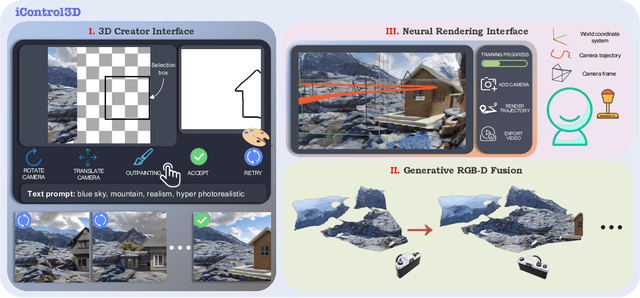

Abstract:3D content creation has long been a complex and time-consuming process, often requiring specialized skills and resources. While recent advancements have allowed for text-guided 3D object and scene generation, they still fall short of providing sufficient control over the generation process, leading to a gap between the user's creative vision and the generated results. In this paper, we present iControl3D, a novel interactive system that empowers users to generate and render customizable 3D scenes with precise control. To this end, a 3D creator interface has been developed to provide users with fine-grained control over the creation process. Technically, we leverage 3D meshes as an intermediary proxy to iteratively merge individual 2D diffusion-generated images into a cohesive and unified 3D scene representation. To ensure seamless integration of 3D meshes, we propose to perform boundary-aware depth alignment before fusing the newly generated mesh with the existing one in 3D space. Additionally, to effectively manage depth discrepancies between remote content and foreground, we propose to model remote content separately with an environment map instead of 3D meshes. Finally, our neural rendering interface enables users to build a radiance field of their scene online and navigate the entire scene. Extensive experiments have been conducted to demonstrate the effectiveness of our system. The code will be made available at https://github.com/xingyi-li/iControl3D.
 Add to Chrome
Add to Chrome Add to Firefox
Add to Firefox Add to Edge
Add to Edge